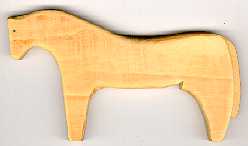|
By Stephen Francis Wyley |

This article is about Viking toy horses, including some basic instructions on how to make one. In particular the Viking toy horse from Trondheim, Norway. Back in 1994 I looked for a simple wood working project and came up with a toy horse and to my amazement I later won the woodworking price at the 1995 Australasian Medieval Conference with it. I have since made numerous similar toy horses an have given most of them away, my son Bryn (nee 30/12/99) even has one. See Figure 1. for a recent effort.
Children of the Viking period had a number different toys to play with; wooden swords, dolls, boats, ducks, cats and horses. The Trondheim toy horse dates from c. 1075 - 1125, the type of wood is not specified, it has a length of 12.7 cm.1. The Trondheim horse represents local production for local consumption as do the other extant toy horse (St.Petersburg and the Faroes). It should be noted that all three are close to thirteen centimeters long, this could mean that such carving has a specific origin and the size is a continuing tradition eventhough the design has been modified.

Figure 2. The original Trondheim Viking toy
horse. 2.
From From Viking to Crusader, p 231.
"Catalogue No. 14.
Wood, L. 12.7 cm, Trondheim, Norway, c.1075 - 1125, Norwegian, Vitenskapsmuseet Trondheim N97259/FU450.
Toy Horse. Stallion carved from a flat piece of wood; the head with mane, the sexual organ and tail are given attention. Parts of the legs and forelegs are damaged.
From the excavations on the Public Library Site where other objects thought to have been toys were found (part of the prow of a toy ship 3.). Most of the toys were horses, carved in a more or less amateur fashion..."
I should note at this time in reference to the damage on the original
Trondheim toy horse that my son Bryn has carried out some tests on his
replica and has produced similar damage. Bryn's use of the horse as a teething
ring and the odd bash on the polished floor boards of our house has resulted
in numerous teeth marks especially on the legs and head, and a broken foreleg
(which I have since re-attached).
Tools; One sharp back bladed knife.
Material; Out of the three toy horsed discussed here only the wood for the Faroes horse as been identified as willow. So I suggest you use willow or any other similar soft found in the region and in the period. I actually used Huon Pine (Tasmania) since I had a plank handy.
Precautions. When cutting towards yourself don't slip or alternatively secure the work with a clap or vice.
Do not coat the toy horse with any toxic substance because this will end up in someone mouth.
Note: I have assumed some notion of wood carving on the part of the carver.
Version 1. (The old fashioned way).
1. Split log into planks about 1.5 to 1.0 cm thick.
2. Mark out outline of toy horse on one side of a plank
3. Carve horse out of a plank.
4. Carve instep on each side of the tail.
5. Carve horses maine.
6. Use point to add depressions for the eyes.
Version 2. (A faster version).
1. Use already dressed planks of wood about 1.5 to 1.0 cm think.
2. Mark out outline of toy horse on one side of plank.
3. Cut from plank using a coping saw or an electric jigsaw (use appropriate
safety gear).
4. Carve shape and details with knife.
5. Finish off with sand paper of increasing finest.

Figure 3. The St. Petersburg (Staraja Ladoga)
Viking toy horse. 4.
From From Viking to Crusader, p 301.
"Catalogue No. 279.
Wood, L. 13.0 cm, Staraja Ladoga (horizon D) obl. St. Petersburg, Russia, 8th - 9th c., Gosudarstremyj Ermitaz, St. Petersburg, LD-244.

Figure 4. The Faroes Viking toy horse.
5.
From From Viking to Crusader, p 310.
"Catalogue No. 315.
Fir, L. 13.2 cm, Kvivik, Streymoy, Faroes, Viking Age, Local, Føroya
Fornminnissavn, Tórshavn, 4765/3797.
1. Trondheim toy horse, Vitenskapsmuseet Trondheim, Norway, N97259/FU450.
2. The original Trondheim Viking toy horse from From Viking to Crusader, p 231.
3. Trondheim toy boat, Vitenskapsmuseet Trondheim, Norway, N30997/FA448.
4. The St. Petersburg (Staraja Ladoga) Viking toy horse from From Viking to Crusader, p 301.
5. The Faroes Viking toy horse from From Viking
to Crusader, p 310.
Almgren, B., et al, The Viking, New York, 1991.
Graham-Campbell, J., The Viking World, London, 1980.
Graham-Campbell, J. & Kidd, D., The Vikings, London, 1980.
Roesdahl, E. & Wilson, D.M., Eds., From Viking to Crusader, The Scandinavians and Europe 800 -1200, Sweden, 1992.
Wilson, D., Ed., The Northern World, London, 1980.
Abbott, M., Green Woodwork: Working with wood the Natural Way, Wiltshire, 1991.
Birkebaek, F., Danmarkshistorien, Vikingetiden, Kobenhavn, 1982.
Brisbane, M., Ed., The Archaeology of Novgorod, Russia, The Society of Medieval Archaeology, monograph 13, 1992.
Corkhill, T., The Complete Dictionary of Wood, 1980.
Foley, D., Toys through the Ages, 1962.
Fridstrøm, E., The Viking Age Wood Carvers, Their Tools and Techniques, Univestetets Oldsaksamlings Skrifter, Oslo, 1985.
Johnson, H., The International Book of Wood, London, 1980.
Kolchin, B.A., Wooden Artifacts from Medieval Novgorod, Oxford, 1989.
Lang, J.T., Viking Age Decorated Wood, Royal Irish Academy, 1988.
Oughton, F., Viking Carving: How to do it, Mansard Press, UK, 1985.
A Replica Viking Chest, based on the Mästermyr Find
How to make a replica of a Viking Table based on the Sala Hytta Find
The Gjermundbu Mail Shirt (The only extant Viking Mail Shirt)
The ‘Lund’ Viking Stool. A Method of Replication
| Copyright © Stephen Francis Wyley 2000 - 2001
svenskildbiter@anglefire.com |